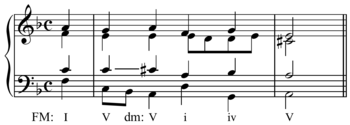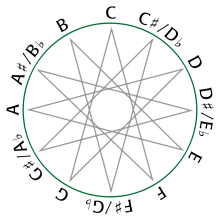- Modulation (music)
-
In music, modulation is most commonly the act or process of changing from one key (tonic, or tonal center) to another. This may or may not be accompanied by a change in key signature. Modulations articulate or create the structure or form of many pieces, as well as add interest. Treatment of a chord as the tonic for less than a phrase is considered tonicization.
Contents
Types
Common chord modulation
Common chord modulation (also known as diatonic pivot chord modulation) moves from the original key to the destination key (usually a closely related key) by way of a chord both keys share. For example, G major and D major share 4 chords in common: G, Bm, D, Em. This can be easily determined by a chart similar to the one below, which compares chord qualities. The I chord in G Major—a G major chord—is also the IV chord in D major, so I in G major and IV in D major are aligned on the chart.
GMaj: I ii iii IV V vi vii° DMaj: IV V vi vii° I ii iii Any chord with the same root note and chord quality (major/minor/diminished) can be used as the "pivot chord." However, chords that are not generally found in the style of the piece (for example, major VII chords in a Bach-style chorale) are also not likely to be chosen as the pivot chord. The most common pivot chords are the predominant chords (ii and IV) in the new key. In analysis of a piece that uses this style of modulation, the common chord is labeled with its function in both the original and the destination keys, as it can be heard either way.
Enharmonic modulation
An enharmonic modulation takes place when one treats a chord as if it were spelled enharmonically as a functional chord in the destination key, and then proceeds in the destination key. There are two main types of enharmonic modulations: dominant seventh/augmented sixth, and diminished seventh -- by respelling the notes, any dominant seventh can be reinterpreted as a German or Italian sixth (depending on whether or not the fifth is present), and any diminished seventh chord can be respelled in multiple other ways to form other diminished seventh chords. By combining the diminished seventh with a dominant seventh and/or augmented sixth, changing only one pivot note at a time, it is possible to modulate quite smoothly from any key to any other in at most three chords, no matter how distant the starting and ending keys; however, the effect is easily overworked.
(Examples: C-E-G-B♭, a dominant 7th, becomes C-E-G-A♯, a German sixth. C♯-E-G-B♭, a C♯ diminished seventh, can also be spelled as E-G-B♭-D♭, an E diminished seventh, G-B♭-D♭-F♭, a G diminished seventh, and B♭-D♭-F♭-A♭♭, a B♭ diminished seventh. Combining the diminished 7th with the dominant 7th/aug.6th: starting again from C♯ diminished seventh, the progression C♯-E-G-B♭, C♯-E-G-A (dom.7th), D-F♯-A takes us to the key of D major; C♯-E-G-B♭, C-E-G-B♭ (dom.7th), C-F-A, to F major; but exactly the same progression enharmonically C♯-E-G-B♭, C-E-G-B♭(dom.7th)=C-E-G-A♯(aug.6th), B-D♯-F♯-B takes us somewhat unexpectedly to B major; C♯-E-G-B♭, C♯-E♭-G-B♭=D♭-E♭-G-B♭(dom.7th), C-E♭-A♭ to A♭ major; etc. )
This type of modulation is particularly common in Romantic music, in which chromaticism rose to prominence.
Common-tone modulation
Common-tone modulation uses a sustained or repeated pitch from the old key as a bridge between it and the new key. Usually, this pitch will be held alone before the music continues in the new key. For example, a held F from a section in B♭ major could be used to transition to F major. This is used, for example, in Schubert's Unfinished Symphony.
Chromatic modulation
A chromatic modulation is so named because it occurs at the point of a chromatic progression, one which involves the chromatic inflection of one or more notes whose letter name, thus, remains the same though altered through an accidental.[1] Chromatic modulations are often between keys which are not closely related.[1] A secondary dominant or other chromatically altered chord may be used to lead one voice chromatically up or down on the way to the new key. (In standard four-part chorale-style writing, this chromatic line will most often be in one voice.) For example, a chromatic modulation from C major to d minor:
CM: IV V/ii ii Dm: i (...) In this case, the IV chord in CM (F major) would be spelled F-A-C, the V/ii chord in CM (A major) spelled A-C♯-E, and the ii chord in CM (d minor), D-F-A. Thus the chromaticism, C-C♯-D, along the three chords; this could easily be partwritten so those notes all occurred in one voice. Despite the common chord (ii in CM or i in dm), this modulation is chromatic due to this inflection.
In the example pictured, a chromatic modulation from FM to dm:
FM: I V dm: V i iv V In this case, the V chord in FM (C major) would be spelled C-E-G, the V in dm (A major) would be spelled A-C♯-E. Thus the chromaticism, C-C♯-D, which is here split between voices but may often easily be part-written so that all three notes occur in one voice.
The combination of chromatic modulation with enharmonic modulation in late Romantic music led to extremely complex progressions in the music of such composers as César Franck, in which two or three key shifts may occur in the space of a single bar, each phrase ends in a key harmonically remote from its beginning, and great dramatic tension is built while all sense of underlying tonality is temporarily in abeyance. Good examples are to be found in the opening of his Symphony in D Minor, of which he himself said (see Wikiquote) "I dared much, but the next time, you will see, I will dare even more..."; and his Trois Chorals for organ, especially the first and third of these, indeed fulfill that promise.
Phrase modulation
Phrase (also called direct or abrupt) modulation is a modulation in which one phrase ends with a cadence in the original key, and begins the next phrase in the destination key without any transition material linking the two keys. This type of modulation is frequently done to a closely related key -- particularly the dominant or the relative major/minor key.
Sequential modulation
Although a sequence does not have to modulate, it is also possible to modulate by way of a sequence. A sequential modulation is also called rosalia. The sequential passage will begin in the home key, and may move either diatonically or chromatically. Harmonic function is generally disregarded in a sequence, or, at least, it is far less important than the sequential motion. For this reason, a sequence may end at a point that suggests a different tonality than the home key, and the composition may continue naturally in that key.
Chain modulation
Distant keys may be reached sequentially through closely related keys by chain modulation, for example C to G to D or C to C minor to E♭ major.[2]
Parallel key modulation
A parallel key modulation is a change of mode, but maintains the same tonal center. For example, one section of a composition may be in the key of E major and then modulate to E minor. This can be done directly or facilitated by the various modulation techniques described above. Depending on the length of the modulation and whether or not it returns to the original key, it may or may not be designated by a change of key signature.
Common modulations
The most common modulations are to closely related keys. V is the most frequent goal and, in minor, III is also a common goal.[4] Modulation to the dominant or the subdominant is relatively simple as they are adjacent steps on the circle of fifths. Modulations to the relative major or minor are also simple, as these keys share all pitches in common. Modulation to distantly related keys is often done smoothly through using chords in successive related keys, such as through the circle of fifths, the entirety of which may be used in either direction:
- D - A - E - B - F♯/G♭ - C♯/D♭ - G♯/A♭ - D♯E♭ - A♯/B♭ - F - C - G - D
If a given key were in G Major, the following chart could be used:
C --' G ' -- D
From G (which is the given key), a musician would go P5 (a perfect fifth) above G (which is D) and also P5 below G (which is C).
From this, the musician would go to G Major's relative minor which is E minor, and potentially to C Major and D Major's related minor as well... a musician who does not know the related minor for C and D Major may also go BELOW or ABOVE E minor.
C-- G -- D ㅣ ㅣ ㅣ a e b
By using the relative minor keys one can find the specific key that the key can MODULATE into.
Many musicians use the circle of fifths to find these keys and make similar charts to help with the modulation.
Significance
In certain classical music forms, a modulation can have structural significance. In sonata form, for example, a modulation separates the first subject from the second subject. Frequent changes of key characterize the development section of sonatas. Moving to the subdominant is a standard practice in the trio section of a march in a major key, while a minor march will typically move to the relative major.
Changes of key may also represent changes in mood. Moving from a lower key to a higher often indicates an increase in energy.
Change of key is not possible in the full chromatic or the twelve tone technique, as the modulatory space is completely filled; i.e., if every pitch is equal and ubiquitous there is nowhere else to go. Thus other differentiating methods are used, most importantly ordering and permutation. However, certain pitch formations may be used as a "tonic" or home area.
Other types
Though modulation generally refers to changes of key, any parameter may be modulated, particularly in music of the 20th and 21st century. Metric modulation (known also as tempo modulation) is the most common, while timbral modulation (gradual changes in tone color), and spatial modulation (changing the location from which sound occurs) are also used.
Modulation may also occur from a single tonality to a polytonality, often by beginning with a duplicated tonic chord and modulating the chords in contrary motion until the desired polytonality is reached.
See also
Further reading
- Vincent Persichetti, Twentieth-Century Harmony. W.W. Norton and Company, 1961. ISBN 0-393-09539-8.
References
- ^ a b Benward and Saker (2003). Music: In Theory and Practice, Vol. I, p.245. Seventh Edition. ISBN 978-0-07-294262-0.
- ^ George T. Jones (1994). HarperCollins College Outline Music Theory, p.217. ISBN 0064671682.
- ^ "Prelude to Musical Geometry", p.364, Brian J. McCartin, The College Mathematics Journal, Vol. 29, No. 5 (Nov., 1998), pp. 354–370. (abstract) (JSTOR).
- ^ Forte, Allen (1979). Tonal Harmony in Concept and Practice, p.269. ISBN 0-03-020756-8.
External links
Categories:- Musical techniques
- Musical scales
- Harmony
- Musical keys
Wikimedia Foundation. 2010.



